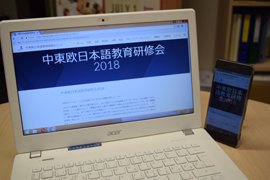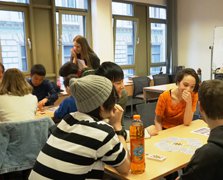JFBP Where People Gather and Grow
The Japan Foundation, Budapest
HAYASHI Toshio/OMURO Fumi
The Japan Foundation, Budapest (hereinafter “JFBP”) supports Japanese-language education in 12 countries in Central and Eastern Europe (Poland, Romania, Bulgaria, the Czech Republic, Serbia, Slovakia, Slovenia, Croatia, Bosnia and Herzegovina, Montenegro, Macedonia, and Kosovo), at the same time, we support Japanese-language education within Hungary and operate Japanese-language courses at the JFBP. In this article, Hayashi, who is in charge of the whole region of Central and Eastern Europe, and Omuro, who is in charge of Hungary itself, introduce their work.
Diverse Environments for Japanese-Language Education
Educational institutions in Central and Eastern Europe start in September, and enter a period of examinations at the end of May. Between December and the beginning of February, there is Christmas and another examination period, so in real terms, it is necessary to travel around each country during the approximately six-month timeframe that avoids these periods when arranging a visiting schedule. During 2017 to 2018, I visited Bulgaria in September, Serbia, Slovenia, and Slovakia in November, Macedonia in December, Poland in March, the Czech Republic in April, and Croatia in May. I inspected Japanese-language educational institutions in each country, and exchanged ideas with relevant parties. Depending on the country, I also attended symposiums or workshops, and, on occasion, was responsible for judging a Japanese speech contest held during the same period.
One commonality in all of the countries in Central and Eastern Europe is that Japanese majors are especially popular in universities, and gather excellent students. Plus, learners who attend private language schools also study with real passion, and proactively participate in lots of different events relating to Japan. On the other hand, there are also visible differences between the countries: Poland boasts the largest number of learners in the Central and Eastern European region, Hungary has the most learners proportionate to the population, and Bulgaria and Romania have large numbers of learners in secondary educational institutions. It is very interesting to note that each country is developing Japanese-language education with different characteristics: comedy culture such as Kyogen and Rakugo has been accepted in the Czech Republic and is strongly reflected in the content of its Japanese speech contests; in Macedonia, haiku (Japanese poetry) is thriving and many people become interested in Japanese culture and learning Japanese through this; the University of Belgrade in Serbia, which has been the center of Japanese studies since the time of the former Yugoslavia, produces Japanese language teachers who work across national boundaries; and the University of Ljubljana in Slovenia aims to offer unique Japanese studies and Japanese language education from an original perspective as a university hub with a great deal of influence in neighboring countries. I believe that they can make good use of the characteristics of these countries in the future as they aim to promote Japanese-language education from each region.
Japanese-Language Education Network in Central and Eastern Europe 2018
The Japanese-Language Education Network in Central and Eastern Europe serves as a once-a-year opportunity for the assembly of teachers involved with the Japanese language in the diverse environments of Central and Eastern Europe. This Network was held in Budapest on February 10 and 11, 2018, and 53 people from a total of 20 countries, including the hosts, met under one roof. It was attended by 12 of the 13 countries mentioned above that are supported by the JFBP (the exception was Kosovo, which is not acknowledged to offer Japanese-language education), as well as participants from Azerbaijan, Italy, Ukraine, Belarus, Moldova, Germany, Japan, and the U.S. We received an application to attend from a single person from Latvia and another from Russia, but unfortunately they could not participate due to the circumstances of their work.
The overall theme for 2018 was “Considering cultural issues in language education”; we invited SATO Shinji, an eminent Content and Language Integrated Learning (CLIL) specialist from the U.S. (Director of the Japanese Language Program at Princeton University), and participants focused on considering cultural issues in Japanese-language education together through participant presentations and group discussions.
The Network has predominantly focused on three areas since 2017. The first was the creation of an “official website” (the Japanese-Language Education Network in Central and Eastern Europe 2018 official website). We have been able to use this to immediately share necessary information. The 2018 version also runs on smartphones, and on the day of the Network all handouts were available online, making it paperless. The second was “establishment of a community through a mailing list.” This served as an opportunity for participants to get to know each other by introducing themselves and creating videos from around one month before the Network, rather than just interacting at the Network as a one-time event. The third area was enriching “group discussion.” Participants engaged in Edcamp-style discussions, in which they held thorough conversations about the theme and brought up topics themselves. I think that through these connections, participants were able to share a feeling of camaraderie, an awareness of issues, and their daily concerns. (Hayashi)

The Japanese-Language Education Network in Central and Eastern Europe 2018 official website also works on smartphones
Communities that Grow with Their Participants
What kind of communities are you involved in where you live? Are there any communities that you wish to do more with?
The JFBP runs Japanese exchange meetings called “Saberjünk!” once every two months (every month until June 2017). Saberjünk! meetings involve talking freely about themes in Japanese, but ensuring consistent participants was a challenge. At that time, we received a proposal from a learner who participated in every meeting, and decided to incorporate a game at the start of the meetings from fall last year. Each time, two members take the lead in offering ideas, and even give explanations on the day. Thanks to the games, the meetings have become livelier, and over the year participant numbers have stabilized, with more and more familiar faces.
I’m delighted that the participants are taking the initiative and acting based on a desire to make Saberjünk! more exciting, and, above all, that I am involved in the development of a community through this. Information about Saberjünk! is also posted on the JFBP Japánnyelvi Kurzuso Facebook page—you should definitely have a look.

Japanese language exchange " Saberjünk" with games
“Let’s Talk About Japanese-Language Education!”
Since last year, we have focused our efforts on the formation of a teachers’ network in Hungary, and have held participant-led meetings called “Let’s talk about Japanese-language education!” once every three months to exchange information and ideas. Up to now, the themes we have tackled include “learning styles” and “my character and vocabulary educational practices.” We are working to ensure that these are meetings in which participants can look back at their practices through discussions with other people and gain energy for their lessons from tomorrow onwards. I’ve also heard pleasing reports that exchanges between teachers have started, triggered by these meetings, and certain teachers from Japan have participated in Japanese-language lessons in secondary schools as guests.
I hope to continue contributing to Japanese-language education in Hungary by creating “places” for new meetings and “triggers” for connections. (Omuro)
- What We Do Top
- Arts and Cultural Exchange [Culture]
- Japanese-Language Education Overseas [Language]
- Japanese-Language Education Overseas [Language] Top
- Learn Japanese-language
- Teach Japanese-language
- Take Japanese-Language Test
- Know about Japanese-language education abroad
- The Japanese-Language Institute, Urawa
- The Japanese-Language Institute, Kansai
- Japanese-Language Programs for Foreign Specified Skilled Worker Candidates
- Japanese Language Education for Japanese Children Resident Overseas and for the Descendants of Migrants
- Archives
- Japanese Studies and Global Partnerships [Dialogue]
- JF digital collection
- Other Programs / Programs to Commemorate Exchange Year
- Awards and Prizes
- Publications
